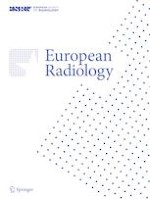Erschienen in:

30.09.2023 | Hepatobiliary-Pancreas
Can absolute arterial phase hyperenhancement improve sensitivity of detection of hepatocellular carcinoma in indeterminate nodules on CT?
verfasst von:
Sara Zafar, Khaled Y Elbanna, Andrew W M Todd, Luis Guimaraes, Ciara O’Brien, Ankur Goel, Tae Kyoung Kim, Korosh Khalili
Erschienen in:
European Radiology
|
Ausgabe 4/2024
Einloggen, um Zugang zu erhalten
Abstract
Objectives
To determine if quantitative assessment of relative (R) and absolute (A) arterial phase hyperenhancement (APHE) and washout (WO) applied to indeterminate nodules on CT would improve the overall sensitivity of detection of hepatocellular carcinoma (HCC).
Methods
One-hundred and fourteen patients (90 male; mean age, 65 years) with 210 treatment-naïve HCC nodules (190 HCCs, 20 benign) who underwent 4-phase CT were included in this retrospective study. Four radiologists independently assigned a qualitative LR (LI-RADS) category per nodule. LR-3/4 nodules were then quantitatively analyzed by the 4 readers, placing ROIs within nodules and adjacent liver parenchyma. A/R-APHE and WO were calculated, and per-reader sensitivity and specificity updated. Interobserver agreement and AUCs were calculated per reader.
Results
Qualitative readers 1–4 categorized 57, 69, 57, and 63 nodules as LR-3/4 respectively with moderate to substantial agreement in LR category (kappa 0.56–0.69, p < 0.0001); their diagnostic performances in the detection of HCC were 80%, 73.2%, 77.4%, and 77.4% sensitivity, and 100%, 95%, 70%, and 100% specificity, respectively. A threshold of ≥ 20 HU for A-APHE increased overall sensitivity of HCC detection by 0.5–3.1% without changing specificity for the subset of nodules APHE − /WO + on qualitative read, with 2, 6, 6, and 1 additional HCC detected by readers 1–4. Relative and various A-WO formulae and thresholds all increased sensitivity, but with a drop in specificity for some/all readers.
Conclusion
Quantitatively assessed A-APHE showed potential to increase sensitivity and maintain specificity of HCC diagnosis when selectively applied to indeterminate nodules demonstrating WO without subjective APHE. Quantitatively assessed R and A-WO increased sensitivity, however reduced specificity.
Clinical relevance statement
A workflow using selective quantification of absolute arterial enhancement is routinely employed in the CT assessment of renal and adrenal nodules. Quantitatively assessed absolute arterial enhancement is a simple tool which may be used as an adjunct to help increase sensitivity and maintain specificity of HCC diagnosis in indeterminate nodules demonstrating WO without subjective APHE.
Key Points
• In indeterminate nodules categorized as LI-RADS 3/4 due to absent subjective arterial phase hyperenhancement, a cut-off for absolute arterial phase hyperenhancement of ≥ 20 HU may increase the overall sensitivity of detection of HCC by 0.5–3.1% without affecting specificity.
• Relative and various absolute washout formulae and cut-offs increased sensitivity of HCC detection, but with a drop in specificity for some/all readers.











